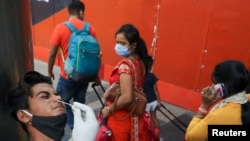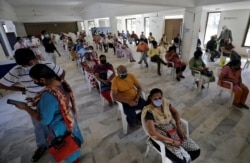India has become the global hotspot for the COVID-19 pandemic, counting the world’s highest numbers of daily new infections in recent days as it grapples with a second wave of the pandemic weeks after witnessing a dramatic decline.
The impact of the swift surge in the virus, in the world’s biggest vaccine maker, will be felt far beyond its shores as India slows vaccine shipments to other countries.
Health experts blame many people in the vast populous country for virtually abandoning COVID protocols as cases tumbled earlier this year.
Huge crowds, mostly without masks, have been jostling at massive political rallies being held in five states holding local elections. A month-long religious festival that sees hundreds congregate daily to take a dip in the river Ganges that Hindus consider holy is underway in the northern state of Uttarakhand. Weddings and family events have become bigger.
Just a day before Mumbai counted its highest numbers of COVID-19 infections, its markets, local trains and beaches were packed. Along with the rest of the country, India’s financial capital had resumed normal life as the daily count of cases dipped by end January in India.
Now, experts say the country is paying the price — the number of infections during this second wave has climbed far more swiftly than the first with daily cases topping the 100,000 mark for the first time this week. On Wednesday, India reported 115,736 infections — its biggest spike since the pandemic began.
“There was a general feeling of comfort across all sections including the policy makers and particularly the public that we had seen the end of the epidemic. There was a feeling that herd immunity had somehow been acquired and that was going to protect India from any further inroads of the virus,” says Srinath Reddy, President of the Public Health Foundation of India. “This was absolutely a misconception and that led to people abandoning public health precautions.”
Health experts say that more infectious variants from Britain, South Africa and Brazil contributed to the swift rise the country is witnessing.
India is unlikely to impose a national lockdown that extracted a huge economic cost, but worst affected areas in the country are reimposing restrictions. The western state of Maharashtra, the country’s most economically developed state, is the epicenter of the new wave reporting nearly 60% of the country’s cases. Its capital, Mumbai, reimposed a partial lockdown this week shutting down shops, restaurants and monuments and ordering a complete shutdown on weekends. The Indian capital, New Delhi has imposed a night curfew.
In cities that had resumed normal life, the millions who had returned to their casual jobs are worried. “I really hope there is no strict lockdown again,” says Kavita Kamble who works as a cook in several homes in Mumbai. “Last year we had no work for six-seven months. We were all sitting at home. Only we know how we coped.”
To stem the rapid rise of infections, India has accelerated its immunization drive which began in January. After inoculating health care workers and senior citizens, health officials began targeting the younger age groups believed to be driving the rising numbers.
"The pandemic isn't over and there is no scope for complacency," Health Minister Harsh Vardhan said on Twitter, urging people to get "vaccinated on your turn and follow COVID-appropriate behavior scrupulously!"
The #Pandemic isn't over and there is no scope for complacency
— Dr Harsh Vardhan (@drharshvardhan) April 7, 2021
On #WorldHealthDay2021 infuse greater zeal to #Unite2FightCorona, get vaccinated on your turn & follow COVID appropriate behaviour scrupulously! @PMOIndia @MoHFW_INDIA #LargestVaccineDrive https://t.co/KSqfJ1xriq
The worst-hit states are urging the federal government to widen the immunization program to all age groups. “There could be an expanded vaccination program in some of the hot districts where there is high level of transmission, but it is only possible if the supply chain of vaccines is adequate,” points out Reddy. “At the moment, the priority is to protect the most vulnerable.”
The country’s accelerated immunization campaign has already resulted in the world’s largest vaccine producer slowing shipments to countries from Indonesia to Africa critically dependent for their rollouts for doses from India.
India, which is making millions of doses of the affordable AstraZeneca vaccine that developing countries are using, is a major cog in the global vaccine chain and a supplier to COVAX, the World Health Organization backed vaccine alliance sharing program. But the temporary hold has affected the flow of doses.
“I really want to deliberately hope that it is a delay, not a ban because that would be catastrophic if that was the case,” John Nkengasong, director of the Africa Centers for Disease Control and Prevention told a news conference earlier this month in Addis Ababa. “Then meeting vaccination schedule becomes problematic, very, very problematic.”
India defended its decision pointing out that it had shipped vaccines to more than 80 countries.
“We have already stated that our external supplies would be done, keeping in mind our domestic requirements,” Arindam Bagchi, Indian Foreign Ministry spokesman, said recently at a press briefing. “At this time, I'm sure our partners understand that vaccines are primarily purposed for domestic consumption.” It has also clarified that there is no outright ban.
India’s own needs are huge. Although the more than 87 million jabs it has administered are among the largest in the world, they have reached less than 7% of the population.
The course of India’s second wave will be critical not just for the vast South Asian nation, but also for other countries waiting to get jabs into as many arms as possible.



